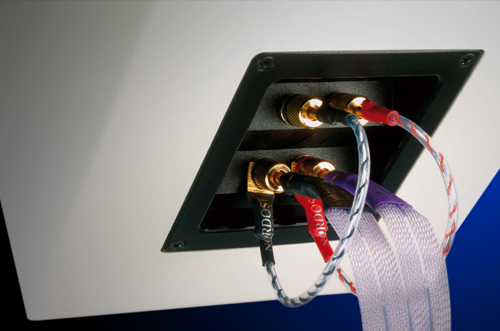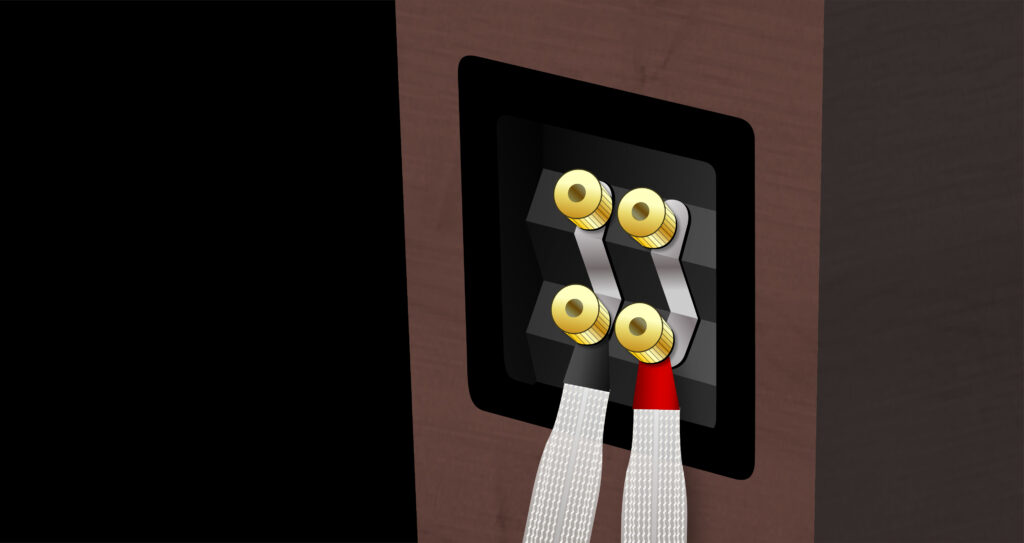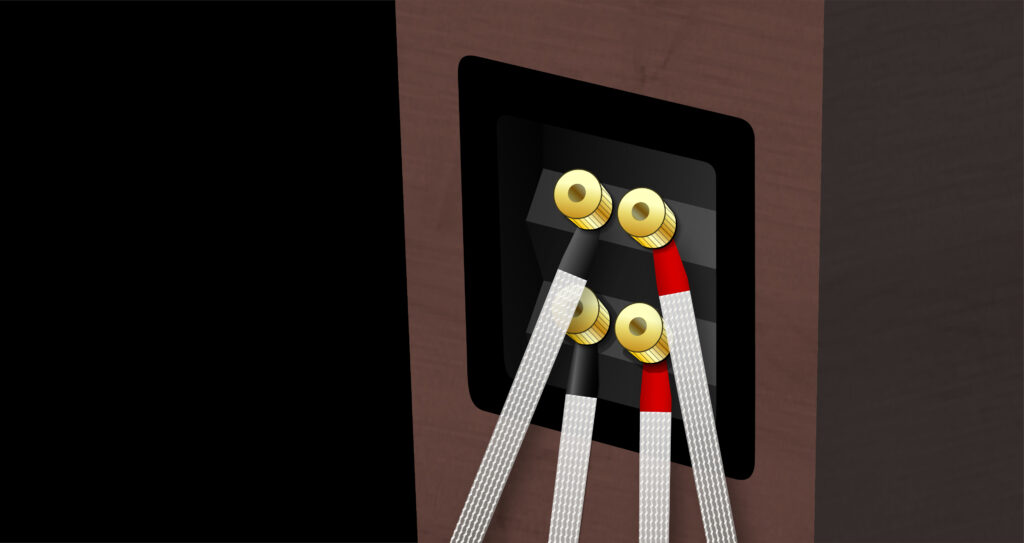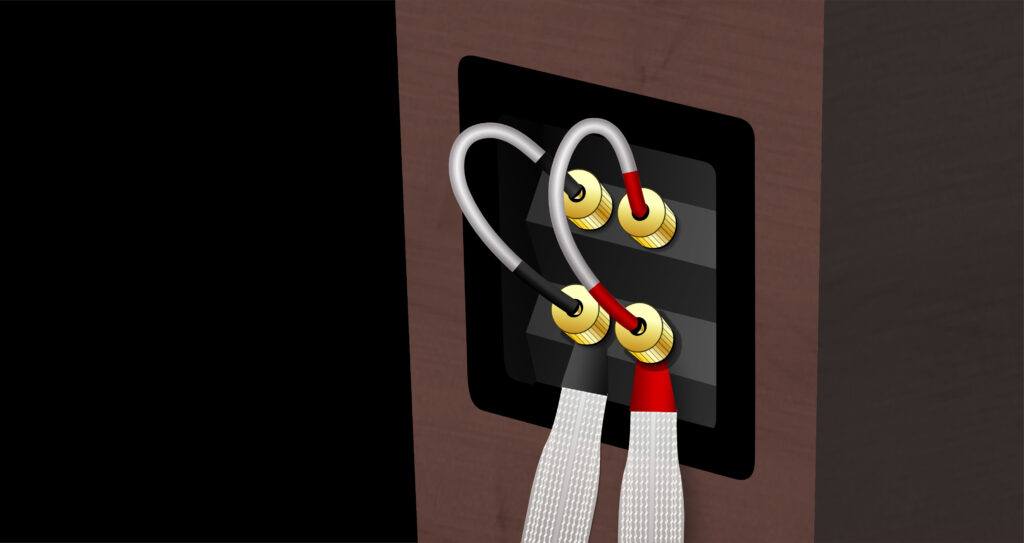
Do your loudspeakers have multiple sets of terminals on their rear panels? If they do, they have been configured with a bi-wire (or possibly tri-wire) crossover. This generally means that they were designed so that one pair of terminals are designated for the high frequencies and the other pair for the low frequencies. Great news—bi-wirable crossovers could mean wonderful audible enhancements for your system! But you have to make sure you’re using this design feature to your advantage, or risk tanking your system’s performance.
When using Bi-Wired Loudspeakers, there are three main cabling options for your set-up: supported shotgun, bi-wire, and bi-wire jumpers. This blog will take you through each option and let you know how they can help (or hinder) your system’s performance level.

“Supported” Shotgun:
Typically, you would use a cable configured in a “shotgun” termination with standard loudspeakers which don’t require bi-wiring. You may ask, “With a bi-wired loudspeaker, how could you possibly support both the tweeters (which support the high frequencies), and the woofer (which supports the low frequencies) with a single run of loudspeaker cables? The answer: you can’t. That’s where the word “supported” comes in.
Many bi-wired loudspeakers are supplied with metal links, which connect the tweeters with the woofer (or vice-versa depending on which pair of terminals you have connected to your amps via your loudspeaker cable). To be clear, at Nordost we do NOT recommend this method. By using these standard, metal links, you are effectively throwing away all the good you’ve done (not to mention the investment you’ve made) with your carefully integrated high-quality audio cables in the last inch of cabling. Naturally, your second question would be, “If metal links are detrimental to the sound, why would a loudspeaker manufacturer provide them with their product?”. Unfortunately, that is a cost issue. In many cases those manufacturers don’t want their design to be prohibitive, so to allow you to use their loudspeakers as soon as they’re purchased, they may include these plates (much like is done with the cheap power cords that are often supplied with electrical components). However, when asked, loudspeaker manufacturers would rarely suggest those plates be used as a permanent solution.

Bi-Wire Cables:
A bi-wire cable is a single run of loudspeaker cable that is terminated with four connectors on the loudspeaker-end instead of two (as is done with shotgun speaker cables). This solution allows you to connect all terminals of a bi-wired loudspeaker without having to buy two pairs of loudspeaker cables, or using standard metal links. In theory, this seems like a good solution, and at Nordost we believe it is a better option than a “supported” shotgun configuration. However, when you bi-wire a loudspeaker cable, you are effectively splitting the cable in fourths in order to serve all terminals. As a result, each terminal makes do with fewer conductors, increasing resistance, and compromising the performance of the loudspeakers.
Alternatively, you could also use two pairs of loudspeaker cables running from your amp to the tweeters and woofer of each loudspeaker, respectively. While this may be the ideal solution, it can become costly, which is where the third option comes in…

Bi-Wire Jumpers:
Bi-Wire Jumpers allow you to use one run of loudspeaker cables to connect your amplifier with your loudspeaker without hindering the performance-level of your system, like you do with standard metal links. At Nordost, our Bi-Wire Jumpers are made using the same technology as our loudspeaker cables, essentially offering an extension of the speaker cable itself. This ensures that an identical sonic signature can be used throughout your entire system, without interruption. Bi-Wire Jumpers are a great way to affordably and immediately integrate bi-wire loudspeakers into your system. This can be either a great long-term solution, or a means to tide you over while you save up for that second pair of quality loudspeaker cables.

Hi,
Pardon my ignorance, but could you please described what is shotgun cabling and how do you connect it to your speakers?
Thank you for your help and time.
Regards
K. Khan
No Problem! Shotgun cabling is a term used in the industry to describe the “standard” termination of a loudspeaker cable. That is when a single line of speaker cable has two connectors at each end (both on the loudspeaker and the amplifier end), one for the Left terminal, and one for the Right terminal. You would use a shotgun speaker cable if your loudspeaker only has two available binding posts (this means that your speakers have an internal crossover connecting their drivers and tweeters).
I currently use AudioQuest Rocket 33 bi-wire cables. Would you suggest also using Nordost bi-wire jumpers as well? My speakers are Tannoy XT 6f and my integrated amp is a NAD MASTERS M32.
We actually recommend using shotgun speaker cables with Norse bi-wire jumpers instead of Bi-wire speaker cables. Bi-wire speaker cables introduce frequency phase inversion where using jumpers does not, it also keeps conductor count higher.
For your bi-wire cable statement as below:
“As a result, each terminal is benefitting from less conductors, increasing resistance, and compromising the performance of the loudspeakers.”
I believe the resistance will be lower by using bi-wire cable in phyiscs theory, could you explain more for your “increasing resistance” conclusion?